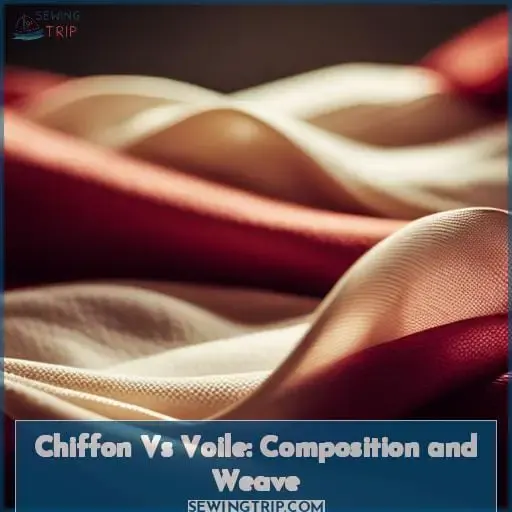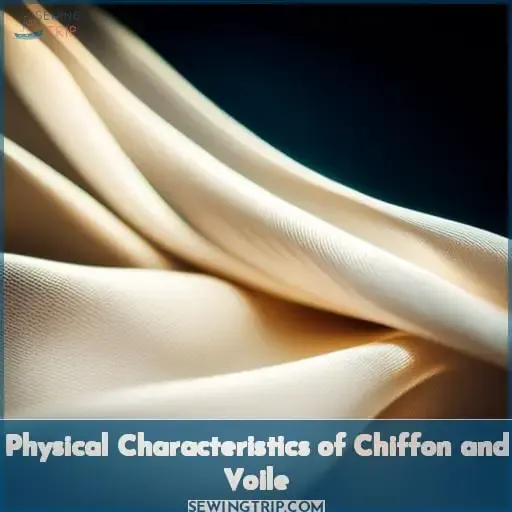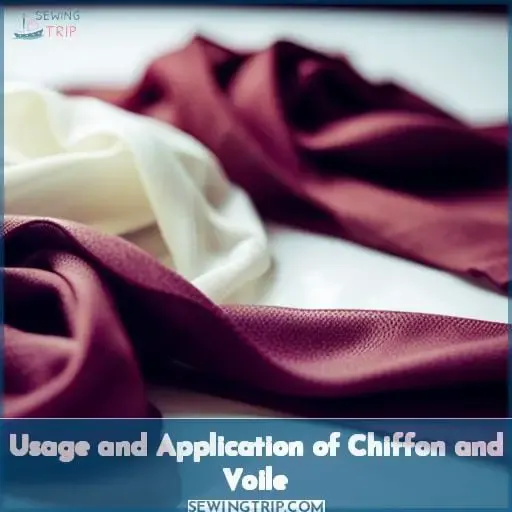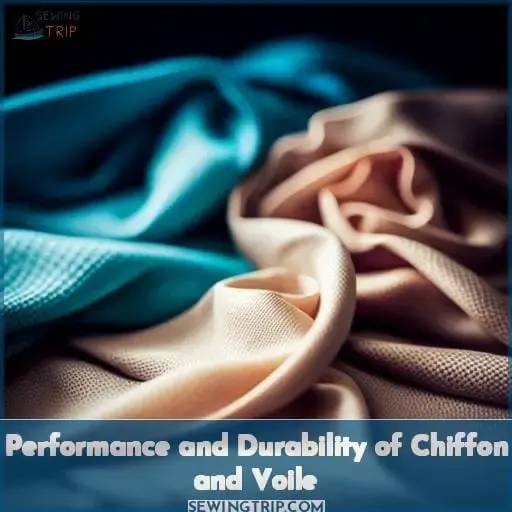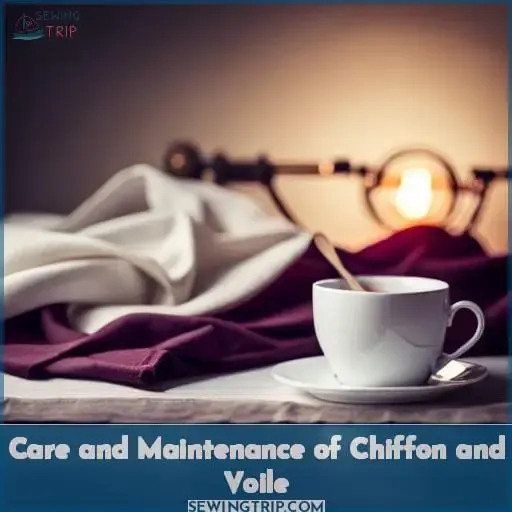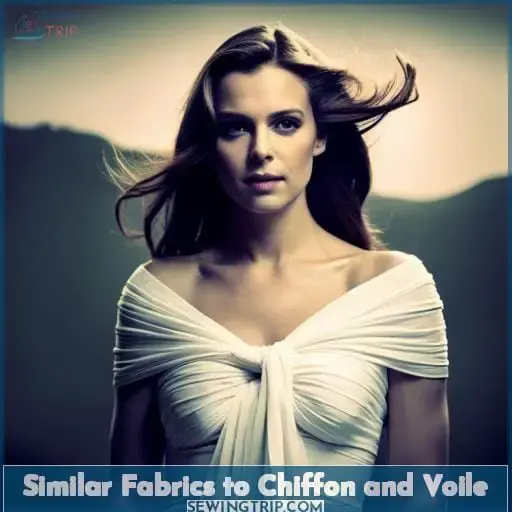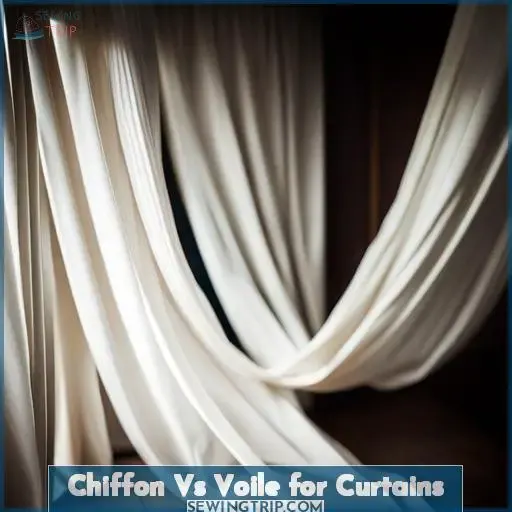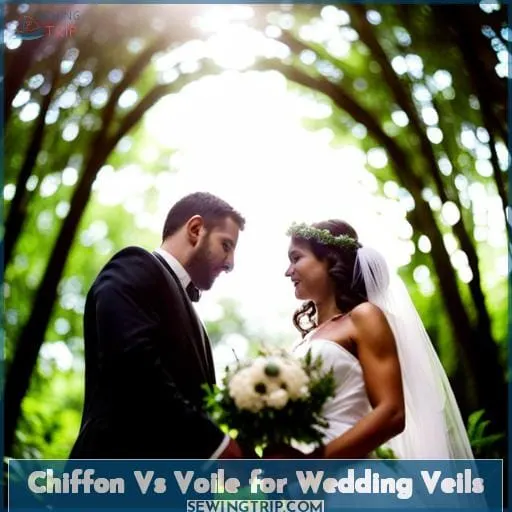This site is supported by our readers. We may earn a commission, at no cost to you, if you purchase through links.
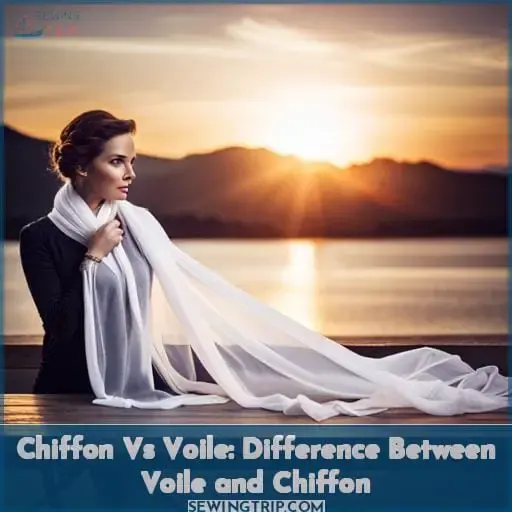 Imagine stepping into the world of fabrics, where chiffon and voile reign supreme. These lightweight and sheer materials may seem similar at first glance, but let us unravel their differences for you.
Imagine stepping into the world of fabrics, where chiffon and voile reign supreme. These lightweight and sheer materials may seem similar at first glance, but let us unravel their differences for you.
Chiffon’s elegant drape and ethereal texture make it a favorite for evening wear, while voile’s sturdy nature lends itself to structured garments with a touch of softness.
Join us as we explore the contrasting qualities of chiffon vs voile and discover which fabric suits your fashion desires best.
Table Of Contents
- Key Takeaways
- Chiffon Vs Voile: Composition and Weave
- Physical Characteristics of Chiffon and Voile
- Usage and Application of Chiffon and Voile
- Performance and Durability of Chiffon and Voile
- Care and Maintenance of Chiffon and Voile
- Availability and Cost of Chiffon and Voile
- Similar Fabrics to Chiffon and Voile
- Chiffon Vs Voile for Curtains
- Chiffon Vs Heavy Chiffon
- Chiffon Vs Voile for Wedding Veils
- Frequently Asked Questions (FAQs)
- Conclusion
Key Takeaways
- Chiffon is made from silk, polyester, or blends, while voile is primarily composed of cotton or cotton blends.
- Chiffon has a soft, slightly rough texture with a diaphanous sheerness, while voile possesses a crisp yet smooth texture with its own level of sheerness.
- Chiffon is more transparent than voile, and chiffon tends to cling more to the body compared to voile.
- Chiffon is often favored for formal wear such as evening gowns or elegant blouses, while voile finds its place in structured garments like wedding veils or tablecloths.
Chiffon Vs Voile: Composition and Weave
Let’s talk about the composition and weave of chiffon and voile.
Chiffon is made from silk, polyester, or blends in a plain weave, giving it a soft texture and slightly rough feel.
On the other hand, voile is primarily composed of cotton or cotton blends with a crisp texture and smooth finish due to its plain weave construction.
Understanding these differences in composition and weave will help you choose the right fabric for your sewing projects.
Chiffon Fabric Composition
Chiffon’s fabric composition consists of silk, polyester, or blends. This sheer and lightweight fabric has evolved over time to offer a luxurious touch of elegance.
While chiffon exudes a slightly rough texture with its plain weave, voile is primarily made from cotton or blended with linen/polyester for added structure.
These synthetic alternatives have gained cultural significance and sustainable blends are becoming more prevalent in the fashion industry.
Voile Fabric Composition
When considering the composition of voile fabric in comparison to chiffon, it’s important to note its distinct qualities and materials.
Voile is primarily made of cotton or cotton blends with a plain weave. It offers a crisp, smooth texture and tends to have a higher thread count compared to chiffon.
Chiffon Weave
Chiffon is woven in a plain weave, which contributes to its lightweight and flowing nature. The Chiffon Weave enhances the fabric’s sheer elegance, allowing it to drape gracefully and create ethereal garments.
It’s important for textile engineers and fashion designers to understand the fabric dynamics of chiffon when designing sheer apparel.
Voile Weave
Now let’s shift our focus to the weave of voile, a fabric that offers distinct differences from chiffon.
- Voile Innovations: Explore the unique weaving techniques and evolutionary fabric blends used in voile production.
- Sheer Textile Trends: Discover how voile is utilized in contemporary fashion for its lightness and transparency.
- Contemporary Voile Uses: Learn about the various applications of voiles, including drapes, blouses, and summer apparel.
Physical Characteristics of Chiffon and Voile
When comparing the physical characteristics of chiffon and voile, there are distinct differences to consider.
Chiffon has a soft, slightly rough texture with a diaphanous sheerness that adds an ethereal quality to garments.
On the other hand, voile possesses a crisp yet smooth texture with its own level of sheerness. It provides structure and durability while maintaining its lightweight nature, making it ideal for structured garments or wedding veils.
Chiffon Texture and Sheerness
As we delve into the physical characteristics of chiffon and voile, it’s important to note their differences in terms of texture and sheerness.
Chiffon has a diaphanous quality with a slightly rougher feel, while voile offers a soft, floaty appearance. These variations in texture contribute to how sheer each fabric appears visually and affects their draping properties during sewing details.
Voile Texture and Sheerness
To understand the difference between voile and chiffon, let’s explore the texture and sheerness of voile.
Voile has a soft, floaty appearance with a crisp, smooth texture.
It’s sheer but offers more body and structure compared to chiffon.
Its light-penetrating quality makes it ideal for drapes and light summer apparel.
Drape of Chiffon
Imagine draping chiffon fabric over your shoulders and feeling its ethereal, flowing drape.
Chiffon’s unique characteristics make it a versatile choice for various styling techniques.
Its lightweight nature allows for innovative drapery designs, adding an element of elegance to garments.
The movement of chiffon creates a dynamic textile experience, encouraging experimentation with different drape styles while maintaining transparency and sophistication in design.
Drape of Voile
When it comes to the drape, voile offers a structured and crisp appearance that sets it apart from chiffon.
The fabric’s smooth texture and higher thread count contribute to its ability to hold shape while still maintaining a light, floaty quality.
Voile’s versatility allows for various styling options, creative layering, and seasonal suitability due to its breathability.
Usage and Application of Chiffon and Voile
When it comes to the usage and application of chiffon and voile, understanding their unique characteristics is key.
Chiffon is often favored for formal wear such as evening gowns or elegant blouses due to its flowing drape, lightweight nature, and subtle shimmer.
On the other hand, voile finds its place in structured garments like wedding veils or tablecloths thanks to its crisp texture, higher durability, and resistance to wrinkling.
Consider these factors when choosing between chiffon and voile for your next project.
Chiffon Usage
Chiffon finds its usage primarily in evening wear, gowns, blouses, and scarves. Its elegant drape and sheer transparency make it perfect for creating flowy and ethereal garments.
When working with chiffon, remember to handle it delicately to avoid damage. It offers versatility in design options due to its lightweight nature and is a go-to fabric for those seeking elegance and grace in their attire.
Voile Usage
Have you ever wondered how voile is commonly used in various applications? Voile offers elegance, versatility, and crispness that make it a popular choice for many projects.
- Drapes and curtains
- Blouses and dresses
- Wedding veils
- Tablecloths and linens
- Light summer apparel
Chiffon for Formal Wear
To elevate your formal wear, chiffon is an excellent choice due to its flowing and ethereal drape.
Compared to voile, chiffon offers a unique combination of sheer delicacy and drapability that adds gracefulness to evening wear. Despite being prone to wrinkles, its drape dynamics make it perfect for formal attire.
| Chiffon | Voile |
|---|---|
| Flowing Drape | Structured |
| Sheer Delicacy | Crisp |
Voile for Structured Garments
For structured garments, voile is a preferred fabric choice due to its crisp texture and higher durability.
- Structured Elegance:
Voile lends itself perfectly to achieving a polished look characterized by sharp lines and defined silhouettes—a must-have quality for any well-constructed outfit destined for empowerment on the runway or in everyday life.
- Versatile Vibes:
One of voile’s greatest assets is its versatility.
Performance and Durability of Chiffon and Voile
When it comes to performance and durability, both chiffon and voile have their unique characteristics.
Chiffon tends to cling more to the body due to its soft texture, while voile offers less clinging.
In terms of transparency, chiffon is highly transparent compared to voile which is semi-transparent.
Both fabrics are breathable but chiffon requires delicate care as it’s more prone to damage, whereas voile is known for its higher durability.
Chiffon Clinging and Transparency
When comparing the performance and durability of chiffon and voile, it’s important to consider their differences in terms of clinging and transparency.
Chiffon has a higher cling factor due to its lightweight nature, while voile offers more structure. Both fabrics provide sheer elegance, but chiffon tends to be more transparent than voile.
| Cling Factor | Transparency | |
|---|---|---|
| Chiffon | High | More Transparent |
| Voile | Low | Less Transparent |
Draping dynamics play a crucial role in the overall look and feel of these delicate veils. Understanding how they interact with your body can help you make informed choices when creating garments or accessorizing for different occasions.
Voile Clinging and Transparency
When it comes to voile, you’ll find that it has a unique performance and durability in terms of clinging and transparency.
- Draping Dynamics: Voile offers a structured yet airy drape that adds movement to your garments.
- Sheer Elegance: With its semi-transparent nature, voile creates an elegant and ethereal look.
- Texture Tales: The crisp texture of voile enhances the overall visual appeal while maintaining breathability for comfort throughout the day.
Chiffon Breathability
Chiffon offers a high level of breathability, allowing air to pass through the fabric easily.
Whether made from silk or cotton, chiffon provides comfort and ventilation, making it a superior option compared to other fabrics like voile or gauze in terms of breathability.
Voile Breathability
To further examine the performance and durability of voile, let’s discuss its breathability.
Here are four reasons why voile is more breathable than chiffon:
- It’s better for summer wear due to its lightweight and airy nature.
- Voile allows for better airflow, keeping you cool in warm weather.
- Unlike chiffon, it’s less likely to cling to the body, allowing for greater comfort.
- Voile’s breathability makes it a preferred choice for structured garments that require ventilation while maintaining their shape.
Care and Maintenance of Chiffon and Voile
When it comes to caring for chiffon, delicate handling is key.
- Silk or nylon chiffon should be dry cleaned.
- Polyester chiffon can be washed with caution due to its susceptibility to distortion when wet.
On the other hand, voile requires a gentler approach and can be either hand-washed or put on a gentle cycle in the washing machine.
After washing, both fabrics benefit from careful stretching and ironing on low heat settings to restore their optimal form and appearance.
Chiffon Care
To properly care for chiffon, follow specific guidelines and take precautions due to its delicate nature.
- Hand wash with gentle detergent or dry clean to avoid damaging the fabric’s elasticity.
- Iron on low heat with a pressing cloth.
- Pay attention to lining and avoid wringing or twisting during washing.
Voile Care
When caring for voile, follow specific care instructions to ensure longevity and quality.
- Use a gentle hand wash cycle or handwash with mild detergent.
- After washing, delicately rinse and dry the fabric.
- To remove any wrinkles, iron on gentle heat settings.
Taking proper care of your voile will maintain its shimmer and preserve its thread count over time while minimizing cost.
Chiffon Wrinkling
If you want to prevent chiffon from wrinkling, handle it with care and avoid excessive folding or creasing.
- Iron on low heat with a pressing cloth.
- Hang chiffon garments instead of folding them.
- Consider using fabric spray for wrinkle prevention.
Voile Wrinkling
Now let’s shift our focus to voile and its tendency to wrinkle, as we continue exploring the care and maintenance of chiffon and voile fabrics.
To prevent wrinkling in voile,
- hand wash with mild detergent,
- gently stretch it back into shape after washing, and
- iron on a gentle heat setting.
Remember these ironing tips for a smooth finish!
Availability and Cost of Chiffon and Voile
When it comes to availability, chiffon and voile are both widely available in fabric stores and online.
You can find a variety of colors and designs for both fabrics, allowing you to choose the perfect option for your project.
In terms of cost, chiffon tends to be slightly more expensive than voile due to its luxurious nature and delicate composition. However, there are affordable options available for both fabrics depending on the material used.
Availability of Chiffon
You can easily find chiffon fabric in a variety of colors and patterns. Here are four ways to get your hands on this versatile fabric:
- Online stores: Browse through numerous options from the comfort of your own home.
- Fabric stores: Visit local fabric shops for a wide selection.
- Department stores: Explore their textile section for chiffon fabrics.
- Boutiques and specialty stores: Discover unique designs and high-quality materials.
Looking for more options? Check out lace, organza, or organdie fabrics which have similarities to chiffon with subtle differences in texture, sheerness, or stiffness.
Now that you know where to find chiffon, unleash your creativity and bring your fashion dreams to life!
Availability of Voile
When shopping for voile, you’ll find a wide availability of this fabric in various stores and online retailers.
It’s commonly stocked in retail shops specializing in fabrics, such as boutiques and department stores. Additionally, there are numerous online platforms that offer a diverse range of voile options to cater to your sewing needs.
| Availability | Online Retailers | Physical Stores |
|---|---|---|
| Voile |
Voile can be conveniently purchased from the comfort of your own home through reputable online retailers that specialize in fabrics and sewing supplies. However, if you prefer the tactile experience or immediate gratification of purchasing fabric firsthand, physical stores like boutiques and department stores also stock voile materials for your convenience.
Cost of Chiffon
Moving on to the cost aspect, chiffon is available in a wide range of prices depending on the material and quality.
Silk chiffon tends to be the most expensive option due to its luxurious nature.
Polyester chiffon is more affordable, while cotton chiffon falls somewhere in between.
The cost of chiffon fabric can vary greatly based on these factors.
Similarly, voile fabric also comes with varying price points depending on its composition and quality.
Cost of Voile
Voile, unlike chiffon, is more affordable and widely available in various fabric stores.
Cotton voile is a popular option due to its cost-effectiveness and versatility.
Silk voile tends to be pricier but offers a luxurious feel and drapes beautifully.
Polyester voile provides an affordable alternative with durability.
Voile is also commonly used for curtains due to its light-penetrating qualities.
Similar Fabrics to Chiffon and Voile
When it comes to fabrics similar to chiffon and voile, there are a few options worth considering.
Organza is one such fabric that shares similarities with chiffon, offering a luxurious finish for evening wear and commonly used in bridal attire and home décor.
Georgette is another option, slightly sheer yet robust enough for evening wear and bridal attire.
Lastly, organdy stands out as the crispiest among cotton fabrics, often used in light summer apparel and home textiles.
These alternatives provide variations of texture while maintaining some of the qualities found in chiffon or voile garments.
Fabrics Similar to Chiffon
If you’re looking for fabrics similar to chiffon, consider organza, organdy, and georgette.
- Organza:
This luxurious fabric offers a slightly stiffer hand compared to chiffon. It has a crisp drape and is often used in evening wear and bridal attire.
- Organdy:
Known for its crispy texture, organdy is lightweight like chiffon but with more body and structure.
- Georgette:
Similar to chiffon in weight, georgette has a slightly rougher texture but still maintains an elegant drape.
- Crepe de Chine:
With its subtle sheen and flowing drape reminiscent of both voile and chiffon combined, Crepe de Chine is another fabric similar to chiffon.
Fabrics Similar to Voile
To further explore fabrics similar to voile, let’s delve into other materials that share similarities with both chiffon and voile. These fabrics offer a range of options for various fashion projects, from delicate evening wear to lightweight summer apparel.
| Fabric | Characteristics |
|---|---|
| Lace | Decorative, available in different materials such as cotton or silk |
| Organza | Luxurious finish ideal for bridal attire and home décor |
Chiffon Vs Voile for Curtains
Choose chiffon or voile for your curtains based on their light-penetrating qualities and suitability for different settings.
When it comes to creating an ambiance in your space, the fabric you choose can make all the difference. Chiffon offers a delicate and ethereal touch to any room with its sheer and transparent nature. Its light-penetrating quality allows subtle sunlight to filter through, creating a soft and dreamy atmosphere that exudes elegance.
On the other hand, if you’re looking for more structured curtains that provide privacy while still allowing some natural light in, voile is your go-to option. With its robust yet lightweight composition, voile strikes the perfect balance between functionality and style.
It offers enough transparency to brighten up a room without compromising on privacy.
Additionally, voile’s breathability makes it ideal for spaces where airflow is crucial; this feature prevents rooms from feeling stuffy or confined by allowing fresh air circulation throughout the day.
However, it’s important to note that chiffon may be more delicate than voile when it comes to durability due to its finer construction; therefore extra care must be taken during handling.
So whether you prefer translucent elegance with chiffon or structured versatility with voile, both fabrics have their unique characteristics suited for various curtain applications.
Chiffon Vs Heavy Chiffon
Now that you understand the differences between chiffon and voile for curtains, let’s delve into another intriguing comparison: chiffon vs heavy chiffon. This particular showdown will shed light on their unique characteristics when it comes to weight, durability, transparency, and cost.
Here is what you need to know:
- Weight: Heavy chiffon is noticeably heavier than regular chiffon due to its denser weave and higher thread count.
- Durability: While both fabrics are delicate in nature, heavy chiffon offers slightly more durability compared to its lighter counterpart.
- Transparency: Chiffons are known for their sheer quality; however, heavy chiffons tend to be less transparent because of their denser construction.
- Cost: Heavy chiffons typically come with a higher price tag compared to regular chiffons.
Chiffon Vs Voile for Wedding Veils
When deciding between chiffon and voile for wedding veils, consider the specific qualities each fabric offers.
Chiffon is a diaphanous and lightweight sheer fabric that creates an ethereal drape, while voile provides more structure and body.
To help you make an informed decision, here’s a comparison table highlighting the key characteristics of both fabrics:
| Chiffon | Voile | |
|---|---|---|
| Weight | Lightweight | Lightweight to medium |
| Shape | Flowing with natural elasticity | Structured |
- Offers graceful drape
- Prone to wrinkling - Resists wrinklesDurability Delicate Moderate Care Requires delicate handling Relatively easy maintenance Cost Varies based on material quality Generally affordable Availability Widely available Widely available Color Wide range of color options Wide range of color options Transparency Highly transparent Semi-transparent Texture Soft with subtle shimmer Crisp and smooth Drape Elegant flowing Structured crisp
Consider these factors when choosing between chiffon or voile for your wedding veil. If you desire a flowing, ethereal look with delicate care requirements, opt for chiffon. On the other hand, if you prefer structured elegance that’s easier to maintain without sacrificing transparency or texture variety then choose voile.
Now that you have this information at your fingertips go ahead confidently select which fabric will best complement your vision on this special day!
Frequently Asked Questions (FAQs)
How do chiffon and voile differ in terms of their breathability and suitability for warm weather?
Chiffon and voile differ in breathability and suitability for warm weather.
Chiffon may not be as comfortable due to its lack of breathability, while voile’s lightweight nature makes it ideal for lightweight summer clothes.
Are there any specific sewing tips or techniques that are recommended when working with chiffon and voile fabrics?
When working with chiffon and voile fabrics, it’s essential to handle them delicately.
- Use tissue paper or weights when cutting.
- Opt for fine needles and suitable thread on your sewing machine.
- Pay attention to seam finishes.
Can chiffon and voile be used interchangeably for certain applications, such as evening wear or lightweight summer apparel?
Yes, chiffon and voile can be used interchangeably for certain applications like evening wear or lightweight summer apparel. Both fabrics offer a delicate, sheer quality with different textures and drapes.
What are the key distinctions between voile and tulle fabrics, and when would one be more suitable than the other?
When choosing between voile and tulle, consider the desired effect:
- Voile falls in soft folds for drapes
- Tulle adds volume as bridal veils or crinolines
Voile lacks elasticity and wrinkles easily compared to tulle’s shape-holding ability.
How do chiffon and voile compare in terms of their cost, and are there any factors that contribute to variations in their pricing?
When it comes to cost, chiffon can vary depending on the material used.
Silk chiffon is the most expensive.
Voile, on the other hand, is generally more affordable in comparison.
Conclusion
To conclude, when it comes to choosing between chiffon and voile, it all boils down to your fashion desires.
Chiffon’s ethereal texture and elegant drape make it perfect for evening wear, while voile’s sturdy nature lends itself to structured garments with a touch of softness.
Both fabrics offer sheer and lightweight qualities, but chiffon is more commonly used for formal occasions while voile is great for everyday wear.
Consider your needs and preferences to determine which fabric suits you best.

